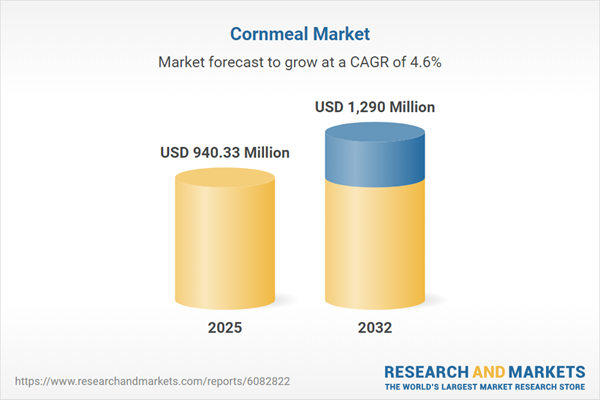Speak directly to the analyst to clarify any post sales queries you may have.
The cornmeal market is experiencing a profound transformation, driven by evolving consumer preferences, regulatory dynamics, and technology-enabled supply chain enhancements. Senior decision-makers require clear, actionable insights to stay ahead in this fast-changing global sector.
Market Snapshot: Cornmeal Market Size, Growth, and Forecast
The cornmeal market grew from USD 899.37 million in 2024 to USD 940.33 million in 2025. It is expected to continue expanding at a 4.63% compound annual growth rate (CAGR), reaching USD 1.29 billion by 2032.
Increasing demand from health-focused segments, ongoing technological improvements, and rising sustainability awareness are fundamentally shaping the market’s trajectory.Scope & Segmentation: Comprehensive Market Coverage
This report offers granular analysis across a range of critical segmentation axes, empowering decision-makers to identify and prioritize market opportunities:
- Product Types: Blue cornmeal, white cornmeal, yellow cornmeal
- End Use: Food service, household
- Distribution Channels: Offline, online
- Particle Size: Coarse, fine, medium
- Type: Conventional, organic
- Regional Coverage:
- Americas: United States, Canada, Mexico, Brazil, Argentina, Chile, Colombia, Peru
- Europe, Middle East & Africa: United Kingdom, Germany, France, Russia, Italy, Spain, Netherlands, Sweden, Poland, Switzerland, United Arab Emirates, Saudi Arabia, Qatar, Turkey, Israel, South Africa, Nigeria, Egypt, Kenya
- Asia-Pacific: China, India, Japan, Australia, South Korea, Indonesia, Thailand, Malaysia, Singapore, Taiwan
- Company Coverage: Anson Mills, Archer Daniels Midland Company, Bunge Limited, Cargill, Incorporated, China National Cereals, Oils and Foodstuffs Corporation, Conagra Brands, Inc., General Mills, Inc., Grain Millers, Inc., Ingredion Incorporated, Tate & Lyle PLC
Key Takeaways: Strategic Insights for Senior Leaders
- Technological advances—including blockchain and IoT-enabled sensors—are enhancing traceability, supporting food safety, and reducing operational inefficiency for cornmeal producers.
- Incorporation of ancient grains and development of superfood blends are expanding product portfolios and improving nutritional value to meet evolving demand for health-oriented foods.
- Growing consumer emphasis on clean labels and sustainability is leading major players to invest in regenerative farming and reduce their carbon footprints.
- Online channels are driving growth for specialty and premium cornmeal products through convenience-focused direct-to-consumer models and digital marketplaces.
- Regional variation in demand—from the heritage traditions in the Americas to emerging urban appetites in Asia-Pacific—requires tailored strategies to optimize market entry and growth.
- Operational resilience and differentiated supply chains support agility as competitive dynamics shift amid regulatory and economic uncertainty.
Cornmeal Market Tariff Impact: 2025 Adjustments
The introduction of new United States tariffs in 2025 on raw corn and milling equipment has compelled producers to re-evaluate procurement strategies. Many domestic manufacturers are shifting toward local sourcing and expanding milling operations to minimize cost exposure. Importers, particularly in food service and retail, are either reformulating product lines or incorporating alternative ingredients to uphold quality and control margins despite increased costs. These tariff adjustments are also incentivizing North American suppliers to target export destinations with favorable trade conditions and streamlined logistics, highlighting the importance of flexible supply chain management.
Methodology & Data Sources
Findings in this report are derived from a mixed-method approach including executive interviews, site visits to operational facilities, secondary data review, and supply chain mapping. Advanced triangulation and expert panel review ensure analytical rigour and reliability for all segment and region-level insights.
Why This Report Matters: Actionable Guidance for Senior Decision-Makers
- Gain clarity on macro- and micro-level market trends and competitive strategies relevant for board-level and operational planning.
- Identify nuanced opportunities by product differentiation, channel development, and regional expansion to optimize resource allocation and strategic investment.
- Benefit from unbiased, data-driven recommendations to navigate technology upgrades, regulatory shifts, and evolving consumer expectations in the global cornmeal market.
Conclusion
Stakeholders equipped with this report will be positioned to anticipate shifts in the cornmeal market, leverage technology and sustainability, and execute on growth strategies aligned to rapidly evolving global dynamics.
Table of Contents
3. Executive Summary
4. Market Overview
7. Cumulative Impact of Artificial Intelligence 2025
Companies Mentioned
The companies profiled in this Cornmeal market report include:- Anson Mills
- Archer Daniels Midland Company
- Bunge Limited
- Cargill, Incorporated
- China National Cereals, Oils and Foodstuffs Corporation
- Conagra Brands, Inc.
- General Mills, Inc.
- Grain Millers, Inc.
- Ingredion Incorporated
- Tate & Lyle PLC
Table Information
| Report Attribute | Details |
|---|---|
| No. of Pages | 193 |
| Published | November 2025 |
| Forecast Period | 2025 - 2032 |
| Estimated Market Value ( USD | $ 940.33 Million |
| Forecasted Market Value ( USD | $ 1290 Million |
| Compound Annual Growth Rate | 4.6% |
| Regions Covered | Global |
| No. of Companies Mentioned | 11 |









